Hiking Meditation: Slowing down and communing with Mother Nature

Did you Google “hiking meditation” or something similar?
If you did, and found this article, then you are one of the approximately 8000 monthly Googlers looking to understand more about hiking and walking meditation. I didn’t know much about the topic, so I asked Will Burkhart, an adventure travel industry friend, to explain to us what hiking and walking meditation is all about.
Will (owner of Badass Adventures) is a professional guide that leads hiking trips, backpacking trips, and guided hiking and walking meditation retreats. I was introduced to Will thru Amy, whom I trained for a 2 day Rim to Rim trip with a company that has since been acquired by REI Adventures. She’d heard about R2R day hikes and hired Will to lead the challenging Grand Canyon endeavor. So, when I was approached by a Kilimanjaro summiting client of mine about doing an iconic domestic trip, I suggested he hire Will for the one day Rim-to-Rim adventure.
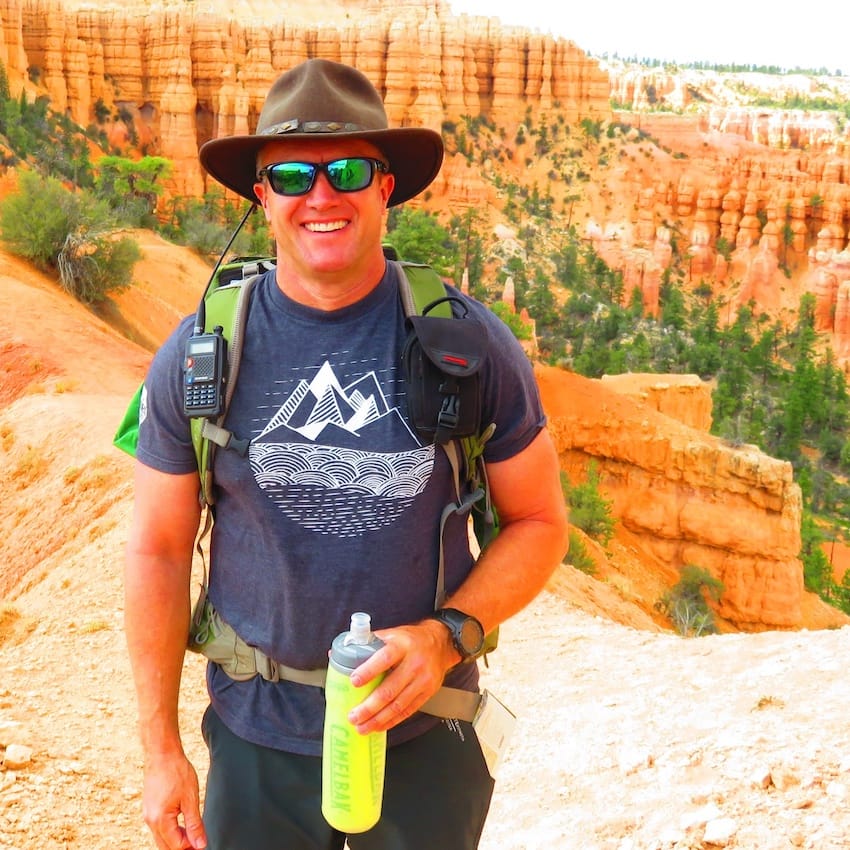
Will is an expert at offering guided walking and hiking meditation retreats, as well as challenging adventures in Arizona.
Will, Tell us All About Walking and Hiking Meditation
As an adventure guide, most of my clients are interested in seeing strikingly beautiful places that they have never been to before. For some it is a “bucket list” place like the Grand Canyon. For others, they want a physical challenge like climbing a 14,000 foot mountain or traversing the Grand Canyon in a day! While these are great reasons to get outside, one of the often-overlooked areas is the therapeutic value of communing with nature. My favorite way to do this is through a hiking and walking meditation. So what does that look like?
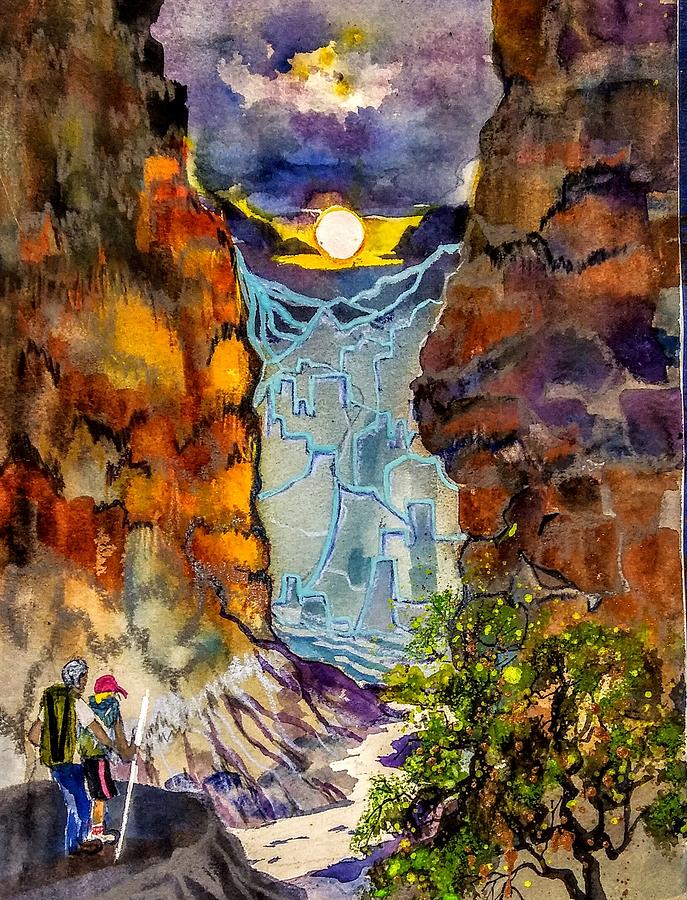 Grand Canyon Splendor is a painting by Esther Woods. Grand Canyon National park is good for both hiking meditation and aggressive hikes.
Grand Canyon Splendor is a painting by Esther Woods. Grand Canyon National park is good for both hiking meditation and aggressive hikes.
When we think of meditation, the image that often comes to mind is sitting in a cross-legged position with our eyes closed and soft music playing in the background. If it is a guided meditation, we might be told to focus on our body sensations or breathing. We might have a mantra that we say to ourselves. While this is a powerful practice, meditation can take other forms, specifically more active practices like hiking and walking meditation.
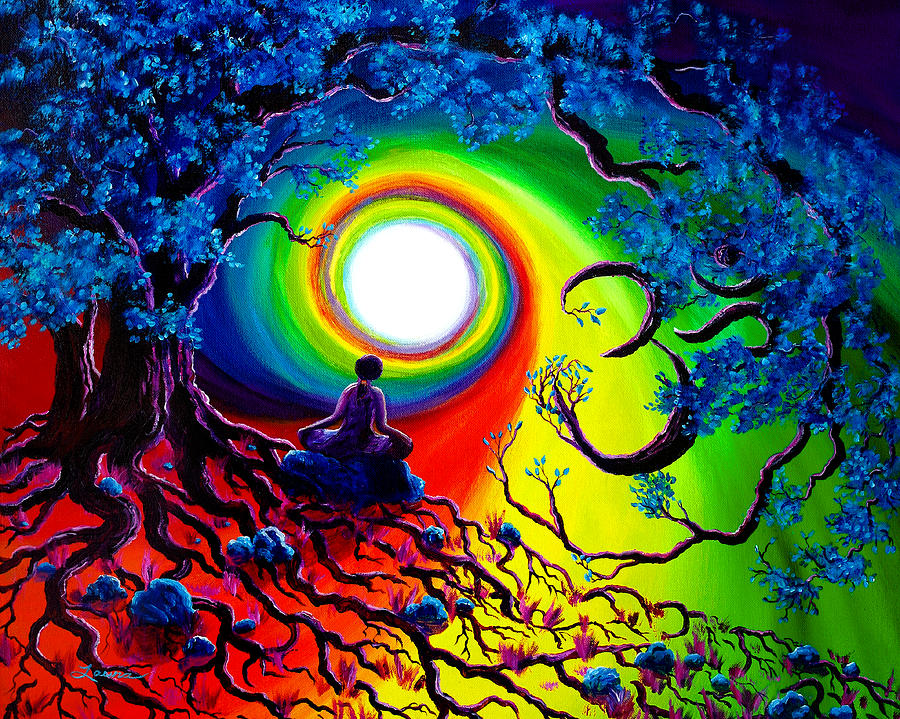 Om Tree of Life Meditation is a painting by Laura Iverson. Walking meditation focuses more on movement vs sitting.
Om Tree of Life Meditation is a painting by Laura Iverson. Walking meditation focuses more on movement vs sitting.
Is hiking a form of meditation?
For some of us, we like to think that hiking is a form of meditation. While that can be true, we need to ask ourselves what the intention is behind our hike. If it is to become more centered and peaceful, more energized and focused, and if we are left feeling nourished and supported, then we have achieved what I believe to be the benefits of a hiking meditation. In my opinion, being outside in a natural setting is the best environment for this activity.
Mother nature is a perfect place to meditate: peaceful with plenty of fresh air and the sounds of the wind and animals providing a calm setting. While most people think to go outside to a remote area and sit to meditate, the meditation can continue as we walk. For those who are unfamiliar with meditating while moving, I provide queues to guide us: feel our breath, be aware of our senses, or witness emotions that we might be experiencing.
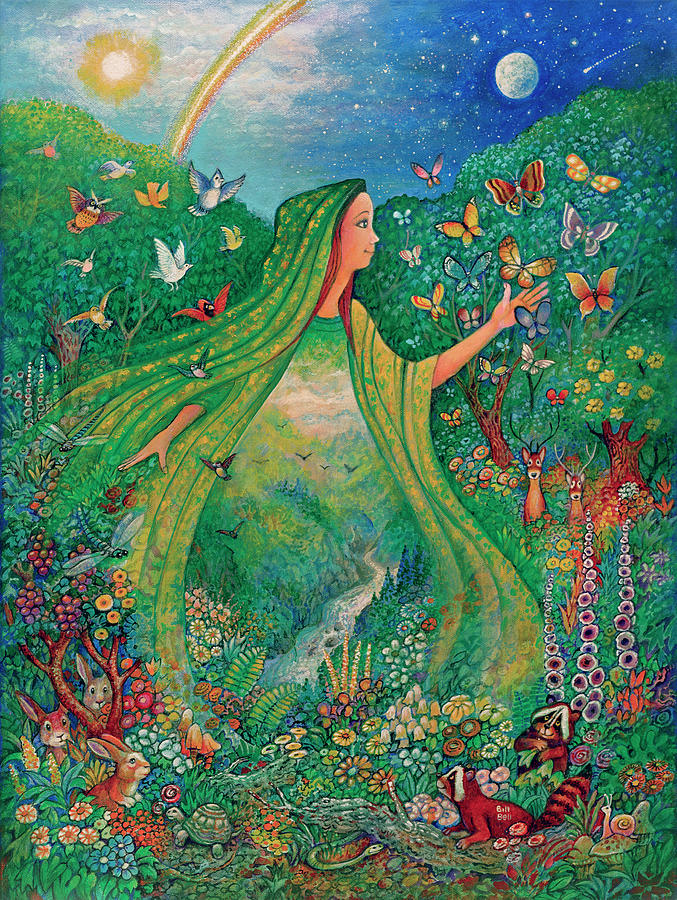 Mother Nature is a painting by Bill Bell. Walking meditation heightens the senses to enjoy all that Mother Earth provides.
Mother Nature is a painting by Bill Bell. Walking meditation heightens the senses to enjoy all that Mother Earth provides.
How do you breathe when walking?
Because meditation is the focus of the hike, we must be in the mindset of moving calmly and deliberately. One of the first areas that I have clients focus on is their breath as they walk. The idea is to move with our breath; moving only as fast as our smooth, deep breathing allows.
Some people wonder if a specific breath pattern is best to follow during a walking meditation. The short answer is no. Initially, I simply want us to bring our awareness to our breath, specifically about the quality of our breathing. Optimally, we want steady deep breathing that invigorates and nourishes us. We do not want our breathing to be a distraction as we connect to other aspects of our walking meditation.
Someone who is hiking to a destination as fast as they can moves through nature, while a hiking meditation requires the mindset of moving with nature. When we are moving through nature, we do not “stop to smell the roses,” but instead focus on the trail in front of us and negotiate the terrain as efficiently as possible. When we are moving with nature, we connect with our surroundings and take in the sights, sounds, smells, and beauty as deeply as possible. Our breath is a good guide to keep us from going too fast and being mindful of our state of being.
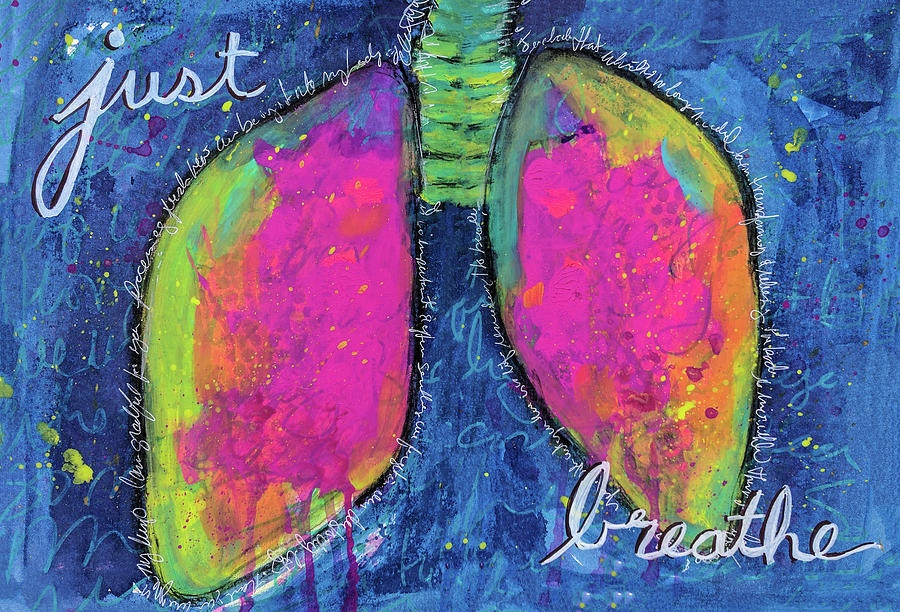 Just Breathe is a painting by Jennifer Russell. Steady deep breathing is integral to hiking meditation.
Just Breathe is a painting by Jennifer Russell. Steady deep breathing is integral to hiking meditation.
How do you meditate while walking?
Preparing for a hiking mediation requires us to follow some steps. Once we have connected with our breath and established our optimal pace, I then focus on our physical senses: the feeling of our feet as they contact the ground; how the wind and air feels on our skin; the sounds of the birds and other animals, as well as the wind driven trees or flowing water; the smells of the flowers and other flora; and the sights of the sky, trees, rock formations, and other aspects that stimulate our senses. The idea is to picture ourselves as multi-sensory antennas tuned to receive the inputs of our natural environment.
Once our physical awareness is heightened, the next step is to bring attention to our emotions. Do we feel calm and at ease with our natural surroundings? If not, what emotions are keeping us from this state? Memories will often catch our attention and make us feel a certain way that takes us out of our ability to maintain our focus on the present moment. The key is to identify our feelings and allow them to be present without distracting us. If we can detach from them and not be controlled by them, then they will fade naturally to the background.
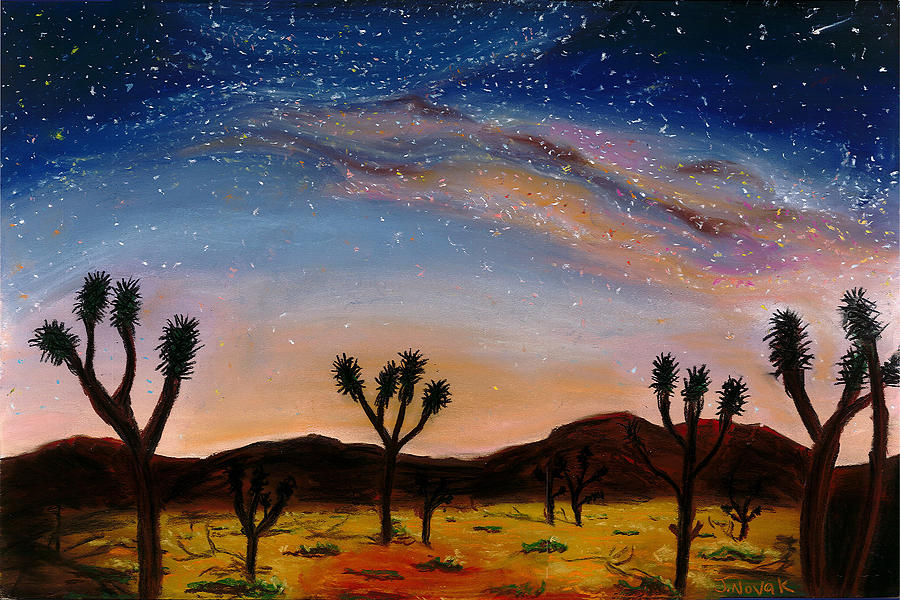 Joshua Trees under the Milkyway is a painting by Jackie Novak. Joshua Tree National Park is a great place for walking meditation.
Joshua Trees under the Milkyway is a painting by Jackie Novak. Joshua Tree National Park is a great place for walking meditation.
What is walking meditation and what are its benefits?
When I was taking a meditative hike in Joshua Tree National Park last spring, I brought attention to my feelings and was overcome by a strong fear of letting people down; my children, my ex-wife, my friends, and even my clients. As I was able to identify the source of these feelings, their intensity and how they were holding me back, I was able to detach from them and let them go. Realizing that open communication and setting realistic expectations would alleviate that fear made letting it go much quicker and easier. It was as if I was lightening my pack and by doing so, I could connect with and feel supported more by the magical beauty of my natural surroundings.
With our physical sensations tuned in and our emotional state calm, our minds will generally quiet and allow us to “meditate” as we move. Sure, thoughts will arise, but we can observe them and let them go more easily as we connect with our breath and feel the nourishment of Mother Nature. For many of us, this is a new, liberating feeling.
Most people who hike for exercise miss much of their surroundings. As they move through nature they are not very connected to their breath, unless it is so labored that they need to stop. While this is great exercise for their heart and will burn calories, the invigoration experienced can be short lived and may be replaced with fatigue at some point. In many instances this is the intention. A hiking meditation can require just as much mental power as hiking vigorously requires physical power.
Hiking or walking with a more meditative mindset will yield a much different experience. We connect with nature through our five senses. We identify and feel our thoughts and emotions and instead of getting fixated on trying to fix them, we simply let them go as we feel the support of our natural surroundings. When we can maintain that state for a period of time, we come away feeling focused, energized, and peaceful.
 A Light Unto My Path is a painting by Spencer Meagher. Hiking meditation would enhance the recognition of light penetration thru the trees.
A Light Unto My Path is a painting by Spencer Meagher. Hiking meditation would enhance the recognition of light penetration thru the trees.
Will talks about guided walking and hiking meditation retreats
I find being able to spend a long weekend for hiking meditation or walking meditation to be the most beneficial. When I organize trips, our first outing is the “decompression hike”. We are disconnecting from the distractions of our everyday life, taking a deep breath, and shedding any baggage that might interfere with bringing awareness to our senses and emotions as we endeavor to connect with a peaceful state on our later hikes. I also like to end the first day with a sunset sit. We will hike to a peaceful place from which to view the setting sun and watch as the natural day draws to an end.
Hikes on the second and third day of the weekend will alternate walking and sitting as we commune with nature, allowing her supportive setting to nurture us as we exercise this new muscle of meditative hiking. I have found that alternating between guided and unguided meditations while we hike or sit to be most effective. Sometimes it is most powerful to simply sit or walk with yourself as you move deeper into meditation.
Some of my favorite destinations for hiking meditations include Sedona, Arizona and Joshua Tree National Park in southern California. Both of those areas have a uniquely powerful energy, as well as some very spectacular landscapes to connect with. Sedona is world renowned for its spectacular red rock formations and energy vortexes. Joshua Tree’s unique flora and amazing boulder formations set in a high desert environment makes for an other-worldly experience.
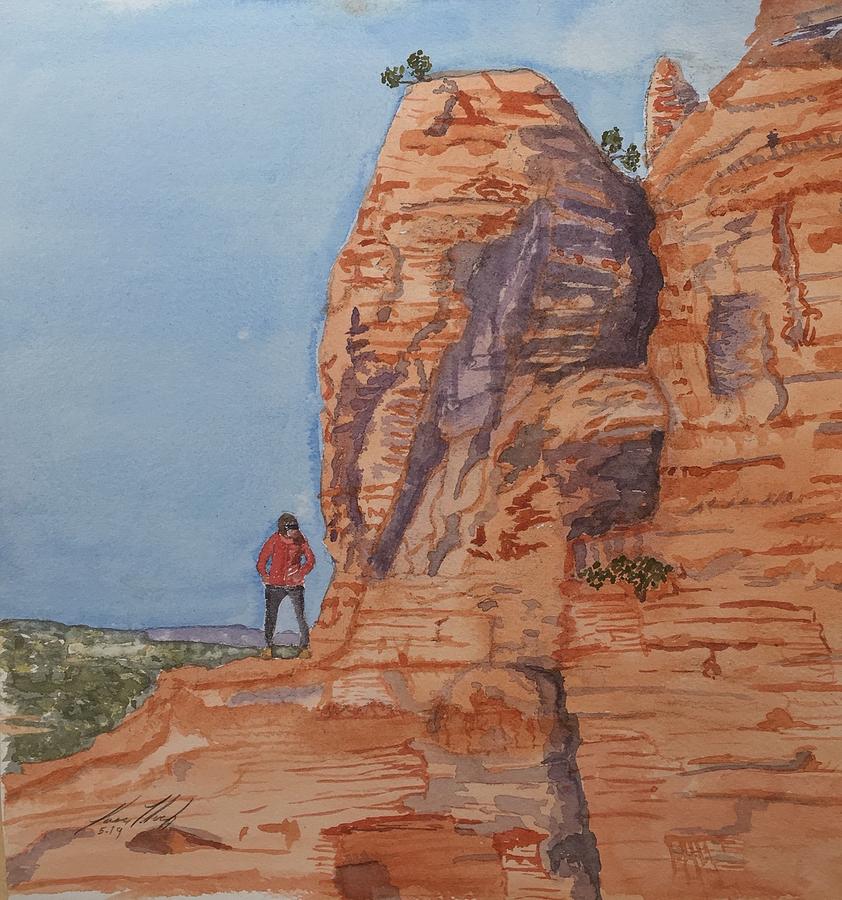 Power of Sedona is a painting by Karen Floch. Sedona is a great destination for hiking and walking meditation.
Power of Sedona is a painting by Karen Floch. Sedona is a great destination for hiking and walking meditation.
Beyond specific destinations, what I mainly look for when doing a hiking meditation are wilderness areas not heavily trafficked. The fewer our fellow hikers and the less man-made distractions, the better. I also want trails that are not too strenuous. If the terrain is more challenging, then I like to have places along the way to stop and do seated meditations.
Weather is also a key factor when considering outdoor meditation of any kind. The calmer and more mild the weather, the better. We don’t want weather conditions to be a distraction from achieving a meditative state of mind. Of course, being prepared for the weather is paramount so that we are dressed properly and hence less negatively impacted. October through May are the best months to hike in the Phoenix area. April through October are the best months to hike up north in Utah and Colorado.
Lastly, I like adding sound healing and movement practices to enhance our time together. I bring Tibetan singing bowls and rely on my years of movement training, such as yoga and tai chi, to enhance our experience. For participants who are open to plant medicines, I have found it to be very effective to add cacao and hape among others to deepen and intensify our experience.
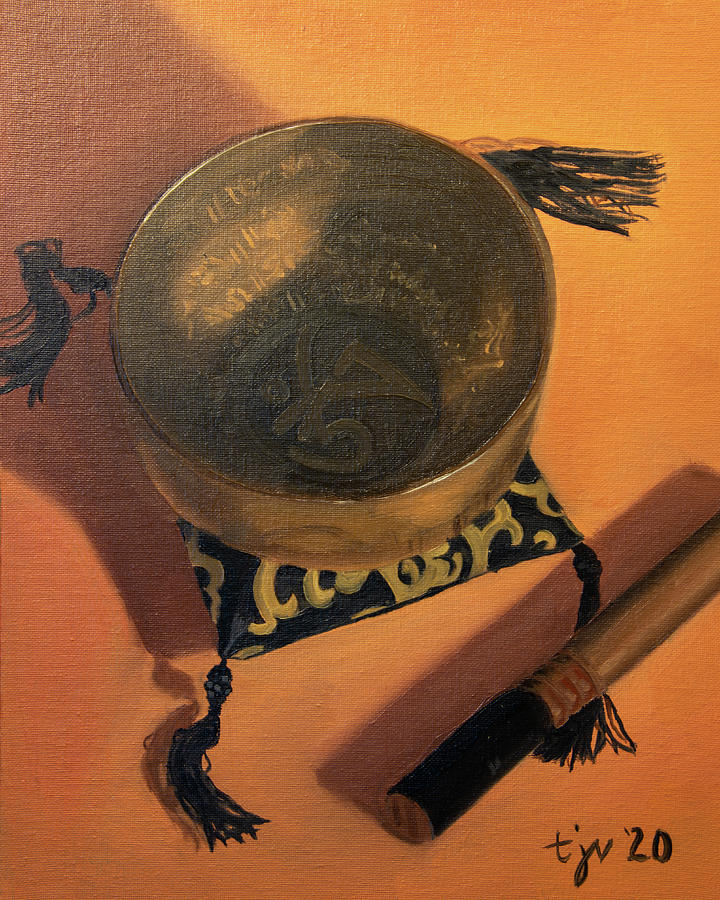 Singing Bowl is a painting by Tari Voydanoff. Help facilitate hiking and walking meditation experience.
Singing Bowl is a painting by Tari Voydanoff. Help facilitate hiking and walking meditation experience.
The beauty of a hiking or walking meditation is that there is no right or wrong way to do it. The more we can get in touch with the curiosity of a childlike mindset, the more open we will be to receiving the benefits of this powerful practice.
Ready to get in shape for your next hike? Contact us for a free fitness consultation.
*All of the artwork published in this article can be found on FineArtAmerica.com.
